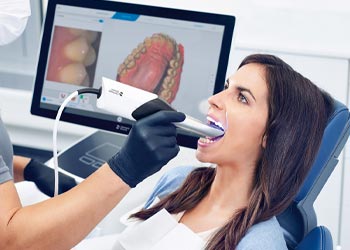Dental Impressions with digital scanner
Dental impressions are negative molds of the teeth and surrounding oral tissues used to create accurate replicas of a patient's dental anatomy. The process involves placing a pliable material, such as alginate, silicone, or polyether, into a tray which is then positioned in the patient's mouth to capture the detailed structure of the teeth and gums. Once set, the impression is removed and sent to a dental laboratory where it is used to produce precise models for treatment planning and appliance fabrication. Accurate dental impressions are crucial for ensuring proper fit, function, and comfort of dental restorations or appliances. Modern advancements have introduced digital impressions using intraoral scanners, which eliminate the need for physical molds and provide instant, highly accurate 3D digital models. Overall, Digital dental impressions in Vijayawada serve as fundamental tools in dentistry, enabling clinicians to plan and execute treatments with high precision and predictability.
Use of dental impressions

Dental impressions are essential for creating accurate models of a patient's teeth and oral structures, which are crucial for various dental procedures. They enable dentists to design and fabricate custom dental restorations such as crowns, bridges, dentures, and implants, ensuring a precise fit that enhances functionality and comfort. Impressions are also vital for orthodontic treatments, allowing for the planning and creation of braces or retainers. Additionally, they assist in diagnosing oral health issues by providing detailed representations of the patient's dentition and soft tissues, helping identify problems like malocclusion, misalignment, or decay. Dental impressions by Dr. Dhiraj Rama Prasad Kadiyala also play a key role in reconstructive and cosmetic dentistry, enabling the production of veneers or crowns that match the patient’s natural teeth. Furthermore, impressions are used to make surgical guides for implant placement, ensuring accuracy during complex procedures. Overall, dental impressions contribute significantly to successful treatment outcomes by providing detailed, custom-fit models that facilitate precise planning, fabrication, and monitoring of dental interventions, ultimately improving patient care and satisfaction.
Digital Dental impressions
Digital dental impressions are a modern, technology-driven method used by dental professionals to capture detailed, accurate images of a patient's teeth and oral structures without the need for traditional putty-based molds. Using advanced intraoral scanners, dentists or orthodontists insert a handheld device that emits a safe light or laser to scan the teeth and gums, creating a real-time, three-dimensional digital model. These digital impressions offer several advantages, including enhanced comfort for patients, as they eliminate the gag-inducing sensation of conventional molds, and increased precision, leading to better-fitting crowns, bridges, aligners, and other dental restorations. The digital files can be easily stored, shared with dental labs, and modified if necessary, streamlining the workflow and reducing turnaround times. Additionally, Digital scanner for dental impressions in Vijayawada facilitate better communication between dental professionals and patients by providing visual representations of dental issues and proposed treatments. Overall, digital dental impressions represent a significant advancement in restorative and orthodontic dentistry, improving accuracy, efficiency, and patient experience through cutting-edge digital technology.
Benefits of digital dental impressions
Digital dental impressions offer numerous benefits, including increased accuracy and precision, which enhance the fit and comfort of dental restorations. They eliminate the need for traditional impression materials, reducing patient discomfort and gag reflex issues. Digital scans are faster, allowing for quicker turnaround times in laboratory processing and treatment planning. The process is more environmentally friendly, as it reduces material waste and eliminates the need for disposable impression trays. Digital impressions facilitate better communication between dental practitioners and laboratories through instant sharing of high-quality, detailed images, leading to improved collaboration and outcomes. They also allow for easy storage and retrieval of patient records without physical space constraints. Additionally, digital impressions enable the use of advanced CAD/CAM technology, leading to the creation of highly precise restorations such as crowns, bridges, and aligners at Dental clinic in Vijayawada. The technology minimizes errors associated with manual impression-taking, leading to fewer remakes and adjustments. Overall, digital dental impressions improve patient experience, streamline workflows, and enhance the quality and longevity of dental restorations, making them a valuable innovation in modern dentistry.